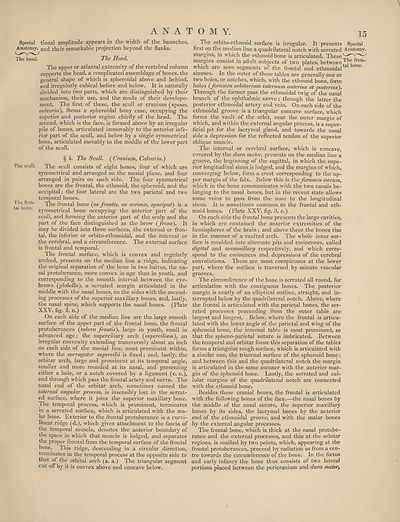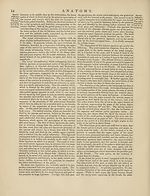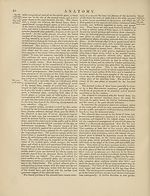Encyclopaedia Britannica > Volume 3, Anatomy-Astronomy
(23) Page 15
Download files
Complete book:
Individual page:
Thumbnail gallery: Grid view | List view

ANATOMY.
Special tional amplitude appears in the width of the haunches,
Anatomy. anj their remarkable projection beyond the flanks.
The head. The Head.
The upper or atlantal extremity of the vertebral column
supports the head, a complicated assemblage of bones, the
general shape of which is spheroidal above and behind,
and irregularly cubical before and below. It is naturally
divided into two parts, which are distinguished by their
mechanism, their use, and the mode of their develope-
ment. The first of these, the scull or cranium (xgav/ov,
calvaria), fbrms a spheroidal bony case, occupying the
superior and posterior region chiefly of the head. The
second, which is the face, is formed above by an irregular
pile of bones, articulated immovably to the anterior infe¬
rior part of the scull, and below by a single symmetrical
bone, articulated movably to the middle of the lower part
of the scull.
§ 4. The Scull. (Cranium, Calvaria.')
The scull. The scull consists of eight bones, four of which are
symmetrical and arranged on the mesial plane, and four
arranged in pairs on gach side. The four symmetrical
bones are the frontal, the ethmoid, the sphenoid, and the
occipital; the four lateral are the two parietal and two
temporal bones.
1 n me1" ^ie ^ronta^ bone (ps fronds, os coronce, synciput) is a
ui >one. Symmetrical bone occupying the anterior part of the
scull, and forming the anterior part of the scalp and the
part of the face distinguished as the brow (from). It
may be divided into three surfaces, the external or fron¬
tal, the inferior or orbito-ethmoidal, and the internal or
the cerebral, and a circumference. The external surface
is frontal and temporal.
The frontal surface, which is convex and regularly
arched, presents on the median line a ridge, indicating
the original separation of the bone in two halves, the na¬
sal protuberance, more convex in age than in youth, and
corresponding to the smooth interval between the eye¬
brows (glabella), a serrated margin articulated in the
middle with the nasal bones, on the sides with the ascend¬
ing processes of the superior maxillary bones, and, lastly,
the nasal spine, which supports the nasal bones. (Plate
XXV. fig. 2. n.)
On each side of the median line are the large smooth
surface of the upper part of the frontal bone, the frontal
protuberances (tubera fronds), large in youth, small in
advanced age; the superciliary arch (supercilium), an
irregular convexity extending transversely about an inch
on each side of the mesial line, most prominent v/ithin,
where the corrugator supercilii is fixed; and, lastly, the
orbitar arch, large and prominent at its temporal angle,
smaller and more rounded at its nasal, and presenting
either a hole, or a notch covered by a ligament (c. c.),
and through which pass the frontal artery and nerve. The
nasal end of the orbitar arch, sometimes named the
internal angular process, is insensibly lost in the serrat¬
ed surface, where it joins the superior maxillary bone.
The temporal process, which is prominent, terminates
in a serrated surface, which is articulated with the ma¬
lar bone. Exterior to the frontal protuberance is a curvi¬
linear ridge (d.), which gives attachment to the fascia of
the temporal muscle, denotes the anterior boundary of
the space in which that muscle is lodged, and separates
the proper frontal from the temporal surface of the frontal
bone. This ridge, descending in a circular direction,
terminates in the temporal process at the opposite side to
that of the orbital arch (a. a.) The triangular segment
cut off by it is convex above and concave below.
The orbito-ethmoid surface is irregular. It presents Special
first on the median line a quadrilateral notch with serrated Anatomy,
margins, in which the ethmoid bone is articulated. These
margins consist in adult subjects of two plates, between fron*
which are seen segments of the frontal and ethmoidal
sinuses. In the outer of these tables are generally one or
two holes, or notches, which, with the ethmoid bone, form
holes (foramen orbitarium internum anterius et posterius).
Through the former pass the ethmoidal twig of the nasal
branch of the ophthalmic nerve ; through the latter the
posterior ethmoidal artery and vein. On each side of the
ethmoidal groove is a triangular concave surface, which
forms the vault of the orbit, near the outer margin of
which, and within the external angular process, is a super¬
ficial pit for the lacrymal gland, and towards the nasal
side a depression for the reflected tendon of the superior
oblique muscle.
The internal or cerebral surface, which is concave,
covered by the dura mater, presents on the median line a
groove, the beginning of the sagittal, in which the supe¬
rior longitudinal sinus is lodged, and the margins of which,
converging below, form a crest corresponding to the up¬
per margin of the falx. Below this is the foramen ccecum,
which in the bone communicates with the two canals be¬
longing to the nasal bones, but in the recent state allows
some veins to pass from the nose to the longitudinal
sinus. It is sometimes common to the frontal and eth¬
moid bones. (Plate XXV. fig. 3. c.)
On each side the frontal bone presents the large cavities,
in which are contained the anterior extremities of the
hemispheres of the brain; and above these the bones rise
in the manner of a vaulted arch. The whole inner sur¬
face is moulded into alternate pits and eminences, called
digital and mammillary respectively, and which corre¬
spond to the eminences and depressions of the cerebral
convolutions. These are most conspicuous at the lower
part, where the surface is traversed by minute vascular
grooves.
The circumference of the bone is serrated all round, for
articulation with the contiguous bones. The posterior
margin is nearly of an elliptical outline, straight, and in¬
terrupted below by the quadrilateral notch. Above, where
the frontal is articulated with the parietal bones, the ser¬
rated processes proceeding from the outer table are
largest and longest. Below, where the frontal is articu¬
lated with the lower angle of the parietal and wing of the
sphenoid bone, the internal table is most prominent, so
that the spheno-parietal suture is imbricated. Between
the temporal and orbitar fossae this separation of the tables
forms a triangular rough surface, which is articulated with
a similar one, the triarcual surface of the sphenoid bone;
and between this and the quadrilateral notch the margin
is articulated in the same manner with the anterior mar¬
gin of the sphenoid bone. Lastly, the serrated and cel¬
lular margins of the quadrilateral notch are connected
with the ethmoid bone.
Besides these cranial bones, the frontal is articulated
with the following bones of the face,—the nasal bones by
the middle of the nasal suture, the superior maxillary
bones by its sides, the lacrymal bones by the anterior
end of the ethmoidal groove, and with the malar bones
by the external angular processes.
The frontal bone, which is thick at the nasal protube¬
rance and the external processes, and thin at the orbitay
regions, is ossified by two points, which, appearing at the
frontal protuberances, proceed by radiation as from a cen¬
tre towards the circumference of the bone. In the foetus
and early infancy the bone thus consists of two lateral
portions placed between the pericranium and dura mater%
Special tional amplitude appears in the width of the haunches,
Anatomy. anj their remarkable projection beyond the flanks.
The head. The Head.
The upper or atlantal extremity of the vertebral column
supports the head, a complicated assemblage of bones, the
general shape of which is spheroidal above and behind,
and irregularly cubical before and below. It is naturally
divided into two parts, which are distinguished by their
mechanism, their use, and the mode of their develope-
ment. The first of these, the scull or cranium (xgav/ov,
calvaria), fbrms a spheroidal bony case, occupying the
superior and posterior region chiefly of the head. The
second, which is the face, is formed above by an irregular
pile of bones, articulated immovably to the anterior infe¬
rior part of the scull, and below by a single symmetrical
bone, articulated movably to the middle of the lower part
of the scull.
§ 4. The Scull. (Cranium, Calvaria.')
The scull. The scull consists of eight bones, four of which are
symmetrical and arranged on the mesial plane, and four
arranged in pairs on gach side. The four symmetrical
bones are the frontal, the ethmoid, the sphenoid, and the
occipital; the four lateral are the two parietal and two
temporal bones.
1 n me1" ^ie ^ronta^ bone (ps fronds, os coronce, synciput) is a
ui >one. Symmetrical bone occupying the anterior part of the
scull, and forming the anterior part of the scalp and the
part of the face distinguished as the brow (from). It
may be divided into three surfaces, the external or fron¬
tal, the inferior or orbito-ethmoidal, and the internal or
the cerebral, and a circumference. The external surface
is frontal and temporal.
The frontal surface, which is convex and regularly
arched, presents on the median line a ridge, indicating
the original separation of the bone in two halves, the na¬
sal protuberance, more convex in age than in youth, and
corresponding to the smooth interval between the eye¬
brows (glabella), a serrated margin articulated in the
middle with the nasal bones, on the sides with the ascend¬
ing processes of the superior maxillary bones, and, lastly,
the nasal spine, which supports the nasal bones. (Plate
XXV. fig. 2. n.)
On each side of the median line are the large smooth
surface of the upper part of the frontal bone, the frontal
protuberances (tubera fronds), large in youth, small in
advanced age; the superciliary arch (supercilium), an
irregular convexity extending transversely about an inch
on each side of the mesial line, most prominent v/ithin,
where the corrugator supercilii is fixed; and, lastly, the
orbitar arch, large and prominent at its temporal angle,
smaller and more rounded at its nasal, and presenting
either a hole, or a notch covered by a ligament (c. c.),
and through which pass the frontal artery and nerve. The
nasal end of the orbitar arch, sometimes named the
internal angular process, is insensibly lost in the serrat¬
ed surface, where it joins the superior maxillary bone.
The temporal process, which is prominent, terminates
in a serrated surface, which is articulated with the ma¬
lar bone. Exterior to the frontal protuberance is a curvi¬
linear ridge (d.), which gives attachment to the fascia of
the temporal muscle, denotes the anterior boundary of
the space in which that muscle is lodged, and separates
the proper frontal from the temporal surface of the frontal
bone. This ridge, descending in a circular direction,
terminates in the temporal process at the opposite side to
that of the orbital arch (a. a.) The triangular segment
cut off by it is convex above and concave below.
The orbito-ethmoid surface is irregular. It presents Special
first on the median line a quadrilateral notch with serrated Anatomy,
margins, in which the ethmoid bone is articulated. These
margins consist in adult subjects of two plates, between fron*
which are seen segments of the frontal and ethmoidal
sinuses. In the outer of these tables are generally one or
two holes, or notches, which, with the ethmoid bone, form
holes (foramen orbitarium internum anterius et posterius).
Through the former pass the ethmoidal twig of the nasal
branch of the ophthalmic nerve ; through the latter the
posterior ethmoidal artery and vein. On each side of the
ethmoidal groove is a triangular concave surface, which
forms the vault of the orbit, near the outer margin of
which, and within the external angular process, is a super¬
ficial pit for the lacrymal gland, and towards the nasal
side a depression for the reflected tendon of the superior
oblique muscle.
The internal or cerebral surface, which is concave,
covered by the dura mater, presents on the median line a
groove, the beginning of the sagittal, in which the supe¬
rior longitudinal sinus is lodged, and the margins of which,
converging below, form a crest corresponding to the up¬
per margin of the falx. Below this is the foramen ccecum,
which in the bone communicates with the two canals be¬
longing to the nasal bones, but in the recent state allows
some veins to pass from the nose to the longitudinal
sinus. It is sometimes common to the frontal and eth¬
moid bones. (Plate XXV. fig. 3. c.)
On each side the frontal bone presents the large cavities,
in which are contained the anterior extremities of the
hemispheres of the brain; and above these the bones rise
in the manner of a vaulted arch. The whole inner sur¬
face is moulded into alternate pits and eminences, called
digital and mammillary respectively, and which corre¬
spond to the eminences and depressions of the cerebral
convolutions. These are most conspicuous at the lower
part, where the surface is traversed by minute vascular
grooves.
The circumference of the bone is serrated all round, for
articulation with the contiguous bones. The posterior
margin is nearly of an elliptical outline, straight, and in¬
terrupted below by the quadrilateral notch. Above, where
the frontal is articulated with the parietal bones, the ser¬
rated processes proceeding from the outer table are
largest and longest. Below, where the frontal is articu¬
lated with the lower angle of the parietal and wing of the
sphenoid bone, the internal table is most prominent, so
that the spheno-parietal suture is imbricated. Between
the temporal and orbitar fossae this separation of the tables
forms a triangular rough surface, which is articulated with
a similar one, the triarcual surface of the sphenoid bone;
and between this and the quadrilateral notch the margin
is articulated in the same manner with the anterior mar¬
gin of the sphenoid bone. Lastly, the serrated and cel¬
lular margins of the quadrilateral notch are connected
with the ethmoid bone.
Besides these cranial bones, the frontal is articulated
with the following bones of the face,—the nasal bones by
the middle of the nasal suture, the superior maxillary
bones by its sides, the lacrymal bones by the anterior
end of the ethmoidal groove, and with the malar bones
by the external angular processes.
The frontal bone, which is thick at the nasal protube¬
rance and the external processes, and thin at the orbitay
regions, is ossified by two points, which, appearing at the
frontal protuberances, proceed by radiation as from a cen¬
tre towards the circumference of the bone. In the foetus
and early infancy the bone thus consists of two lateral
portions placed between the pericranium and dura mater%
Set display mode to:
![]() Universal Viewer |
Universal Viewer | ![]() Mirador |
Large image | Transcription
Mirador |
Large image | Transcription
Images and transcriptions on this page, including medium image downloads, may be used under the Creative Commons Attribution 4.0 International Licence unless otherwise stated. ![]()
| Encyclopaedia Britannica > Encyclopaedia Britannica > Volume 3, Anatomy-Astronomy > (23) Page 15 |
|---|
| Permanent URL | https://digital.nls.uk/193757647 |
|---|
| Attribution and copyright: |
|
|---|---|
| Shelfmark | EB.16 |
|---|---|
| Description | Ten editions of 'Encyclopaedia Britannica', issued from 1768-1903, in 231 volumes. Originally issued in 100 weekly parts (3 volumes) between 1768 and 1771 by publishers: Colin Macfarquhar and Andrew Bell (Edinburgh); editor: William Smellie: engraver: Andrew Bell. Expanded editions in the 19th century featured more volumes and contributions from leading experts in their fields. Managed and published in Edinburgh up to the 9th edition (25 volumes, from 1875-1889); the 10th edition (1902-1903) re-issued the 9th edition, with 11 supplementary volumes. |
|---|---|
| Additional NLS resources: |
|

